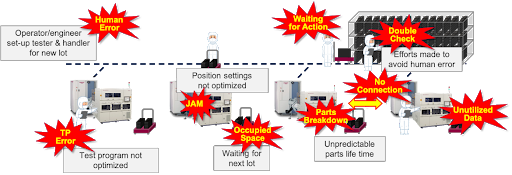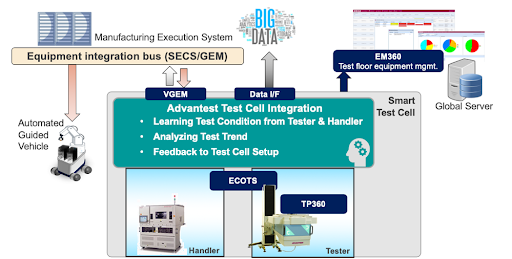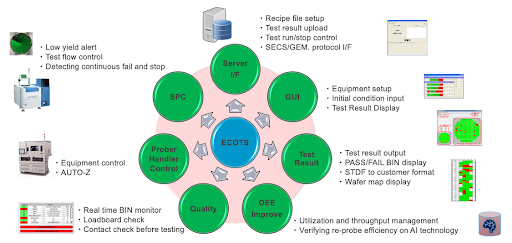Enabling Smart Manufacturing
By Tan Cheak Hong, Technical Pre-sales Manager, Advantest
Widely considered the next industrial revolution, smart manufacturing is quickly becoming an important aspect of semiconductor production and test. Combining the physical and virtual worlds, a smart plant can operate at higher levels of productivity and energy efficiency and turn out higher-quality products.
Today’s typical manufacturing site, however, incorporates a number of inefficiencies that can interrupt the manufacturing flow and impact the test process, potentially affecting test times and costs. The typical production test flow shown in Figure 1 illustrates some of these factors.

Figure 1. A typical test flow can be impacted by several factors that create operational inefficiencies.
The first factor is the test program itself. If the program is developed upstream on an engineering-level tester, it may not be optimized for downstream implementation, as the OSAT provider may have more limited resources for production. Next, human error can be introduced when an operator or engineer manually inputs the production lot information to set up the tester and handler.
Further challenges can arise if there are errors in the position settings on the handler, so that it’s not optimized for production, which may cause it to jam. Physical problems are created when parts are loaded into handlers and waiting to be tested because of limited valuable space currently available on the test floor, or equipment breakdowns cause unscheduled downtime. Another issue is when a tester is localized with no connection to the back-end system; all data is stored in the local tester, filling up the hard disk and causing a slowdown and system crash if it is not monitored. Data that is collected but never utilized is a waste of resources.
Finally, additional opportunities for human error are introduced when lack of automation means that an operator just clear a jam or, at the end of a lot, perform a manual count and then reload the system for retest. Having to pause the flow so an operator to come and take care of these problems is highly inefficient.
In a smart test site, these problems are eliminated. No human error occurs because the entire process is automated, from the start of the lot to execution of the test program. Everything is connected all the way through to ensure smooth operation and efficient use of resources.
Getting to automation
Advantest has developed a concept for through-factory solution to aid in automating the flow, from test cell to production (Figure 2). The manufacturing execution system connects an automated guided vehicle (AGV), used to move material efficiently through the line, to the integrated test cell “Virtual Gem,” or VGEM, Advantest’s patented SECS/GEM Interface Solution for factory automation. VGEM can be easily customized to meet a customer’s specific SECS/GEM requirements, and enables full factory automation with Advantest tester platforms.

Figure 2. Advantest’s automated test flow solution resolves inefficiencies to enable optimized operation.
The Easy and convenient Operation ToolS (ECOTS) enables evolutionary factory automation. The smart test cell collects and integrates data from the handler and tester and then feeds it via data interface to the cloud, where AI techniques are used to analyze the data based on learned test conditions and provide actionable results. For example, AI can be applied to the measurement data to analyze prober pin cleaning, probe card lifecycle, probe quality, and other parameters. The tester incorporates a sensor to handle all the data moving through it so that the data collection and analysis can be performed quickly and seamlessly.
The ATE is also equipped with Advantest’s TP360 software toolset designed to enhance productivity. This value-added software performs test program debug/optimization and correction, helping speed up the test program release process. From there, the results are fed out to the EM360 equipment-management toolset. This smart toolset helps improve overall equipment effectiveness (OEE), system utilization, time to quality and time to market.
Figure 3 summarizes all the capabilities and efficiencies enabled by ECOTS. The solution was initially developed for the T2000 SoC/mixed-signal platform, and has now been ported to the V93000, T6391 and, soon, the Memory platform, allowing smart manufacturing techniques to be implemented for virtually any type of device. Key benefits include automated recipe and equipment setup, wafer-map display, efficient resource management, improved uptime, real-time bin monitoring and equipment control, and statistical process control (SPC) capabilities, which use real-time data mining to adapt and evolve the flow to eliminate low yield, continuous fail/stop and other problems that can bring production to a halt.

Figure 3. Advantest’s ECOTS test cell solution is highly customizable and delivers a range of ease-of-use benefits to the user.
As automation becomes more widely integrated into the test flow, smart manufacturing techniques will become essential to ensuring the process is efficiently managed. Advantest has developed a unique solution, combining its proven ATE and handler technology with new proprietary software and interfaces, to enable customers to optimize their test flow, streamline test times and costs, and bring the new products to market more quickly
